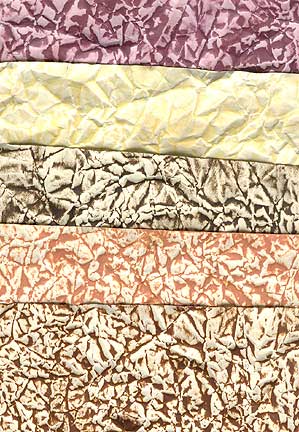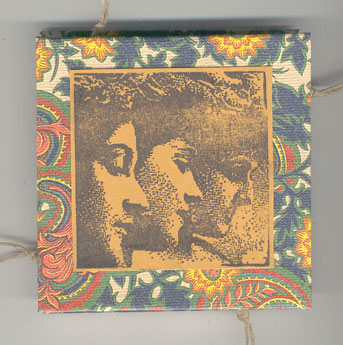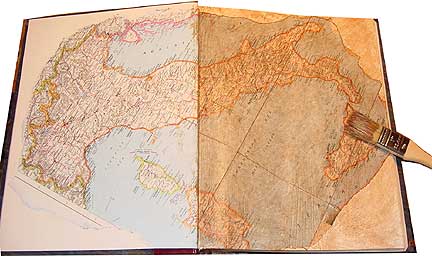Originally posted in October, 2004. Updated in September, 2008.
AB
The abbreviation for altered book.
Acid Free (Neutral pH)
Papers that are without acid in the pulp. Materials that are pH neutral (about 7) or alkaline (7 or higher) buffered. If prepared properly, papers made from any fiber can be acid free.
Acid Migration
Acid transfer from an acidic material to a less acidic or neutral-pH material. Generally occurs when neutral materials are exposed to atmospheric pollutants or when two paper materials come in contact. Acid can also migrate from adhesives, boards, endpapers, protective tissues, paper covers, acidic art supplies, and memorabilia.
Adhesive Binding
Single sheets or signature held together by an adhesive such as a PVA or hot melt instead of by sewing.
Archival
Anything labeled archival should be acid free and lignin free.
Archival Paper
A paper with long-standing qualities, acid free, lignin free, usually with good color retention.
Assemblage
A sculptural technique of organizing a group of unrelated objects into a unified whole.
Artist Trading Card
A 2-1/2 x 3-1/2 inch card traded between artists.
ATC
The abbreviation for artist trading card.
B
Bands
The leather-covered cords that cross the spine of a book, forming ridges.
Binder’s Board
A stiff gray board used for the covers of books.
Book Block
The text pages of a book or pamphlet.
Bone Folder
A flat plastic or bone tool used to impress lines or creases into paper, and to create smooth, sharp folds.
Brad
A small metal fastener, usually with a rounded head, and a two-pronged tail meant to be bent in opposite directions.
Bristol
A heavy-weight paper such as that used for file folders.
Buffering
The neutralizing of acids in paper by adding an alkaline substance (usually calcium carbonate or magnesium carbonate) into the paper pulp. The buffer acts as a protection from the acid in the paper or from pollution in the environment.
C
Cabinet Card
A style of photograph which was adopted for photographic portraiture in 1870, consisting of a thin photo that was usually mounted on heavy cards. Cab cards usually measure roughly 4-¼ by 6-½ inches.
Caliper
The thickness of paper expressed in thousands of an inch.
Cardstock
Paper stock stiff enough for the printing of business cards.
Carte de Visite or CDV
A type of small photograph patented in France in 1854, usually made of an albumen print, mounted on a thicker paper card. The photo is usuall 2-1/8 × 3-1/2 inches mounted on a 2-1/2 × 4 inch card.
Case
The protective cover around the book, made separately and then joined to the book block.
Casing-In
Attaching a case to the book block.
Cellulose
The chief constituent of the cell walls of all plants. All plants contain tissue that, when properly processed, will yield cellulose. Cotton in its raw state contains about 91% and is the purest form of natural cellulose. Other sources for papermaking include hemp (77%), softwoods & hardwoods (57% to 65%), and kozo (66% to 77%).
Cold Pressed
A paper surface with slight texture produced by pressing the finished sheet between cold cylinders.
Collage
An artwork composed of materials and objects glued onto a surface.
Collate
Checking the proper order of all paginated and unpaginated pages before sewing a book.
Cotton Linters
Fibers that adhere to cottonseed after ginning. Used as raw material to produce pulp for cotton fiber content papers.
D
Deckle Edge
The feathery edge which is the result of the natural run-off of wet pulp when making handmade and mouldmade paper, or the result of sheets being torn when wet. The edge is simulated in machine made papers by cutting them with a stream of water when still wet.
Decoupage
The technique of decorating an object with cut-outs of paper or other flat materials over which varnish or lacquer is applied.
Dimensional Stability
The degree to which a paper will maintain its size and shape when subjected to changes in moisture content and relative humidity.
E
Endpapers or Endsheets
Blank leaves at the beginning and end of a book or pamphlet. These can be plain or decorated.
F
Felt Finish
Surface characteristics of paper formed at the wet end of a paper machine, using woven wool or synthetic felts with distinctive patterns to create a similar texture in the finish sheets.
Felt Side
The top side of the paper, usually recommended for best printing results.
Fiber
The slender, thread-like cellulose structures that cohere to form a sheet of paper.
Filler
A generic term to describe the non-oxidizing clays or minerals added to the pulp at the beater stage to improve paper density.
Finish
Describes the surface of the paper, usually as matte, gloss or semi-gloss.
Finishing
The cutting, sorting, trimming and packing of paper.
Flyleaves
The free-swinging portion of an endpaper.
Folio
A sheet of paper folded once, which forms two leaves or four pages.
Formation
The arrangement of fibers in a sheet of paper; can be seen by holding it up to a light source.
Found Object
An object that was found by the artist. Usually, something that has been picked up from the ground, or found rather than purchased.
Foxing
Rust-colored spots that develop in paper, usually due to high humidity and impurities present in the paper.
G
Gampi
A bast fiber from the gampi tree used in Japanese papermaking to yield a smooth, strong sheet.
Gloss Finish
A highly reflective, shiny surface.
Grain
Direction of fibers in a sheet of paper. Long grain describes fibers running parallel to the longest side of a sheet. short grain running parallel to the short side.
Gutter
The inner margins of the pages, close to the spine.
H
Handmade Paper
Paper made by hand using a mould (a frame covered with a flat, rigid screen or flexible screen). In both cases the mould is covered by a flat frame called a deckle, to contain the run-off of wet pulp, dipped into a vat of wet pulp, shaken to distribute the fibers evenly and drained of its excess water. The wet mat of fibers remaining in the newly formed sheet is then dried against blankets & may be hot pressed, cold pressed, or air dried.
Head
Top of the book or top of the spine.
Headband
A decorative embroidered strip of cloth glued at the head and tail of the spine of the book.
Headcap
The covering that has been shaped over the headbands at the head and tail of the spine of a hand bound book.
Hot Pressed
A paper surface that is smooth, produced by pressing a finished sheet through hot cylinders.
High Alpha Cellulose
A very pure form of wood pulp which is considered to have the same longevity as cotton or other plant fibers.
I
Inchie
A one-inch square piece of artwork.
J
Joints
The flexible area on the outside of the binding where the spine and the boards of the book connect.
Joss Paper
Sheets of decorative bamboo paper or rice paper that are burned in traditional Chinese deity or ancestor worship ceremonies on special holidays. Also known as ghost money.
K
Kozo
The most common fiber used in Japanese papermaking, it comes from the mulberry tree. A long, tough fiber that produces strong, absorbent sheets.
L
Laid Papers
Papers with a “grid” pattern in the sheet, resulting from the pulp resting against wires on the papermaking mould screen. “Laid” lines are closely spaced while “chain” lines are farther apart & run parallel with the grain direction of the sheet, important when folding papers, especially to bookbinders.
Leaf
A piece of paper consisting of two pages, one on each side (the recto and the verso).
Lightfastness
The speed at which a pigment or colored paper fades in sunlight.
Lignin
A component of the cell walls of plants that occurs naturally, along with cellulose. Lignin is largely responsible for the strength and rigidity of plants, but its presence in paper is believed to contribute to chemical degradation. To a large extent, Lignin can be removed during manufacturing.
M
Machinemade Paper
Paper made on a very rapid running machine called a “Fourdrinier”, producing consistent quantities of sheets or rolls.
Matte Finish
A non-reflective, flat surface.
Methylcellulose
A pure adhesive, suitable for archival mounting, that dries clear.
Mitsumata
A bast fiber used in Japanese papermaking that yields a soft, absorbent and lustrous quality.
Moo Card
A 1 1/8 x 2 3/4 inch card, originally named for the company that started printing cards in this format.
Mouldmade Paper
Paper made by a slowly rotating machine called a cylinder mould that simulates the hand-papermaking process. Fibers become more randomly intertwined than in machinemade papers, producing a stronger, more flexible sheet or roll.
N
Nap
The slight directional surface texture of some writing surfaces.
O
P
Parchment
Animal skins or linings stretched and prepared as writing/painting surfaces. Produces a smooth, buttery surface.
pH
In chemistry, pH is a measure of the concentration of hydrogen ions in a solution, which is a measure of acidity or alkalinity. The pH scale runs from 0 to 14 and each number indicates a ten fold increase. Seven is pH neutral: numbers below 7 indicate increasing acidity, with 1 being the most acid. Numbers above 7 indicate increased alkalinity with 14 being the most alkaline. Paper with a pH below 5 is considered highly acidic. Buffered papers typically have a pH between 8.5 and 9.5.
Ply
A single layer of paper. A term used when several sheets of paper are laminated together to form a board.
PPA
The abbreviation for Perfect Paper Adhesive, a type of glue manufactured for use on paper.
Pulp
Any cellulose plant fiber cleaned and beaten into a wet mixture used to form sheets of paper.
PVA (Polyvinylacetate)
An archival white glue that is stronger than gel medium. It mixes well with gloss medium. Transparent even after many coats and remains water soluble. Mixed with gel it becomes water resistant.
Q
R
Rag
Formerly the principal raw material used in the making process; often meaning cotton rags. Rag content describes the amount of cotton fiber relative to the total amount of material used in the pulp. “Rag content” is not widely used (or is a misnomer) today as more and more high quality paper is made not from rag but from linters.
Recto
The front of a leaf or document, or the right hand page of an open book.
Rice Paper
A common misnomer used to describe Oriental papers. There are no papers made from rice, although rice starch was traditionally used to size papers made of Kozo (mulberry plant), Gampi, or Mitsumata.
Rinchie
A one-inch round piece of artwork.
Rough
A heavily textured paper surface produced by placing wet sheets of paper against textured blankets or air drying (or both).
S
Score
To impress a line or crease into a piece of paper to create a fold line. Usually done with a scoring blade or a bone folder.
Semi-Gloss Finish
A semi-reflective, satin surface.
Signature
The pages formed by the folding of a single sheet. The number of pages depends on the number of times the sheet is folded. A sheet folded once makes a folio (2 leaves, 4 pages): twice, a quarto (4 leaves, 8 pages); three times, an octavo (8 leaves, 16 pages)
Size or Sizing
The process by which gelatin rosin, starch or other synthetic substance is added to paper to provide resistence to the absorption of moisture or eliminating ink feathering and bleed through. Sizing added to the beater or vat of pulp is known as internal sizing. After a sheet is formed, it may be either surface sized (painted or brushed on the surface), or tub sized (immersed in a bath).
Spine
The bound edge of a book.
Sulphite
Sulphite pulp is produced from the wood of coniferous trees. Wood chips are cooked in calcium bisulphate or sodium sulphite, and bleached, producing fairly long strong fibers. From the end of the 1860’s until recently, it has been the most widely used pulp in America. In fact, the term “sulphite” has become generic and is still accurately used to describe any paper made from wood.
T
Tip or Tip-in
To attach an item such as a letter or an illustration into a bound book by applying a narrow line of adheseive on one of its edges.
Tooth
A very slight surface texture of paper preferred for dry media such as charcoal and pastel.
Turn-in
The covering material that is turned inside around all edges of the boards.
Twinchie
A two-inch square piece of artwork.
U
V
Vellum
Traditionally, an animal skin that has been treated with lime and stretched and scraped rather than tanned, used for writing, printing and binding books. Vellum is also used to designate heavy weight, translucent drawing or drafting papers.
Verso
The back of a document or page or the lefthand page of an open book.
W
Waterleaf
An absorbant paper with little or no sizing.
Watermark
The translucent design or name easily visible when a sheet is held to the light. A design is sewn onto the papermaking screen with raised wire. When the sheet is formed, the pulp settles in a thinner layer over the wire design.
Web
The continuous ribbon of paper, in its full width, during any stage of its progress through the paper machine.
Weight
Expressed in pounds. The higher the number, the heavier and thicker the paper.
Wheat Paste
An archival adhesive for book arts.
Wove Paper
Papers which show no fine laid lines running through the sheet when held to the light.
Wrapper
A protective enclosure constructed of Bristol or other lightweight board.
X
Y
Z



